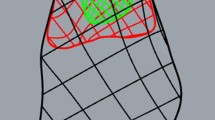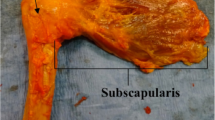Abstract
Purpose
Evaluation of the biomechanical performance of repairs of 25 % (Fox/Romeo II) and 50 % (Fox/Romeo III) full-thickness subscapularis tears using a single-suture anchor.
Methods
Six pairs of human cadaver specimens were used for the testing. Artificial subscapularis tears were created in order to simulate a 25 % (6) and a 50 % (6) full-thickness tear. The reconstructions were made with a double-loaded suture anchor (5.5-mm Bio-Corkscrew with two No. 2 Fiberwire) creating a double-mattress suture repair. Reconstructions were cyclically loaded from 10 to 60 N. The load was increased stepwise up to 100 and 180 N. Cyclic displacement (means + standard dev.) as well as load-to-failure was determined, and mode of failure was recorded.
Results
In the reconstructed shoulders at 60 N, a mean cyclic displacement of 3.2 ± 0.7 mm was found in the 25 % tear, 2.6 ± 0.6 mm in the 50 % tear. At 100 N, 5.1 ± 1.2 mm was seen in the 25 % tear and 4.3 ± 0.3 mm in the 50 % tear. At highest load of 180 N, 7.6 ± 2.2 mm was recorded in the 25 % tear, 6.5 ± 0.8 mm was found in the 50 % tear. Ultimate failure load was 486 ± 167 N in the 25 % tear and 455 ± 213 N in the 50 % tear. Statistically significant differences between the tested repairs were seen neither in cyclic displacement nor in ultimate failure loads (p > 0.05). Mode of failure revealed bone fractures and anchor pull-out as major cause in the 25 % group, whereas failure of the suture–tendon interface was the major cause of failure in the 50 % group.
Conclusions
Subscapularis repair using a single double-loaded suture anchor revealed similar biomechanical performance in 25 % compared to 50 % full-thickness subscapularis tears. With increased tear size, however, an optimized suture–tendon interface seems to become more relevant in order to decrease failure rate of the repair.
Clinical relevance
A single double-loaded suture anchor provides sufficient biomechanical strength even in Fox/Romeo grade III tears of the subscapularis tendon. However, a modified suture configuration is recommended, especially in grade III tears as the suture–tendon interface is the weakest point of the construct.









Similar content being viewed by others
References
Ahmad CS, Wing D, Gardner TR, Levine WN, Bigliani LU (2007) Biomechanical evaluation of subscapularis repair used during shoulder arthroplasty. J Shoulder Elbow Surg 16:S59–S64
Arai R, Sugaya H, Mochizuki T, Nimura A, Moriishi J, Akita K (2008) Subscapularis tendon tear: an anatomic and clinical investigation. Arthroscopy 24:997–1004
Aydin N, Kocaoglu B, Guven O (2010) Single-row versus double-row arthroscopic rotator cuff repair in small- to medium-sized tears. J Shoulder Elbow Surg 19:722–725
Barber FA, Herbert MA, Schroeder FA, Ziz-Jacobo J, Mays MM, Rapley JH (2010) Biomechanical advantages of triple-loaded suture anchors compared with double-row rotator cuff repairs. Arthroscopy 26:316–323
Bartl C, Imhoff AB (2007) Management of isolated subscapularis tendon tears. Orthopade 36:848–854
Bennett WF (2001) Subscapularis, medial, and lateral head coracohumeral ligament insertion anatomy. Arthroscopic appearance and incidence of “hidden” rotator interval lesions. Arthroscopy 17:173–180
Burkhart SS, Brady PC (2006) Arthroscopic subscapularis repair: surgical tips and pearls A to Z. Arthroscopy 22:1014–1027
Burkhart SS, Johnson TC, Wirth MA, Athanasiou KA (1997) Cyclic loading of transosseous rotator cuff repairs: tension overload as a possible cause of failure. Arthroscopy 13:172–176
Burks RT, Crim J, Brown N, Fink B, Greis PE (2009) A prospective randomized clinical trial comparing arthroscopic single- and double-row rotator cuff repair: magnetic resonance imaging and early clinical evaluation. Am J Sports Med 37:674–682
Charousset C, Grimberg J, Duranthon LD, Bellaiche L, Petrover D (2007) Can a double-row anchorage technique improve tendon healing in arthroscopic rotator cuff repair?: a prospective, nonrandomized, comparative study of double-row and single-row anchorage techniques with computed tomographic arthrography tendon healing assessment. Am J Sports Med 35:1247–1253
Denard PJ, Ladermann A, Burkhart SS (2011) Double-row fixation of upper subscapularis tears with a single suture anchor. Arthroscopy 27:1142–1149
Deutsch A, Altchek DW, Veltri DM, Potter HG, Warren RF (1997) Traumatic tears of the subscapularis tendon. Clinical diagnosis, magnetic resonance imaging findings, and operative treatment. Am J Sports Med 25:13–22
Fox J, Romeo AA (2003) Arthroscopic subscapularis repair. Annual Meeting of the American Academy of Orthpedic Surgeons, New Orleans
Franceschi F, Ruzzini L, Longo UG, Martina FM, Zobel BB, Maffulli N, Denaro V (2007) Equivalent clinical results of arthroscopic single-row and double-row suture anchor repair for rotator cuff tears: a randomized controlled trial. Am J Sports Med 35:1254–1260
Gerber C, Hersche O, Farron A (1996) Isolated rupture of the subscapularis tendon. J Bone Joint Surg Am 78:1015–1023
Gerber C, Schneeberger AG, Beck M, Schlegel U (1994) Mechanical strength of repairs of the rotator cuff. J Bone Joint Surg Br 76:371–380
Gerber C, Schneeberger AG, Perren SM, Nyffeler RW (1999) Experimental rotator cuff repair. A preliminary study. J Bone Joint Surg Am 81:1281–1290
Gerhardt C, Hug K, Pauly S, Marnitz T, Scheibel M (2012) Arthroscopic single-row modified mason-allen repair versus double-row suture bridge reconstruction for supraspinatus tendon tears: a matched-pair analysis. Am J Sports Med 40:2777–2785
Grasso A, Milano G, Salvatore M, Falcone G, Deriu L, Fabbriciani C (2009) Single-row versus double-row arthroscopic rotator cuff repair: a prospective randomized clinical study. Arthroscopy 25:4–12
Hughes RE, An KN (1996) Force analysis of rotator cuff muscles. Clin Orthop Relat Res 330:75–83
Katthagen JC, Jensen G, Muller T, Voigt C, Lill H (2012) Subscapularis tendon lesions. Anatomy, diagnosis and importance of arthroscopic treatment. Unfallchirurg 115:817–827
Kim SJ, Jung M, Lee JH, Park JH, Chun YM (2014) Arthroscopic repair of a significant (>50 %) partial-thickness subscapularis tear concomitant with a full-thickness supraspinatus tear: technical considerations for subscapularis repair (transtendon technique versus tear completion). J Shoulder Elbow Surg. doi:10.1016/j.jse.2014.10.009
Koh KH, Kang KC, Lim TK, Shon MS, Yoo JC (2011) Prospective randomized clinical trial of single-versus double-row suture anchor repair in 2- to 4-cm rotator cuff tears: clinical and magnetic resonance imaging results. Arthroscopy 27:453–462
Lafosse L, Jost B, Reiland Y, Audebert S, Toussaint B, Gobezie R (2007) Structural integrity and clinical outcomes after arthroscopic repair of isolated subscapularis tears. J Bone Joint Surg Am 89:1184–1193
Longo UG, Berton A, Marinozzi A, Maffulli N, Denaro V (2012) Subscapularis tears. Med Sport Sci. 57:114–121
Lorbach O, Anagnostakos K, Vees J, Kohn D, Pape D (2010) Three-dimensional evaluation of the cyclic loading behavior of different rotator cuff reconstructions. Arthroscopy 26:S95–105
Lorbach O, Bachelier F, Vees J, Kohn D, Pape D (2008) Cyclic loading of rotator cuff reconstructions: single-row repair with modified suture configurations versus double-row repair. Am J Sports Med 36:1504–1510
Lorbach O, Kieb M, Raber F, Busch LC, Kohn D, Pape D (2012) Comparable biomechanical results for a modified single-row rotator cuff reconstruction using triple-loaded suture anchors versus a suture-bridging double-row repair. Arthroscopy 28:178–187
Lorbach O, Kieb M, Raber F, Kohn D, Pape D (2013) Three-dimensional evaluation of cyclic displacement in single-row and double-row rotator cuff reconstructions under a static external rotation. Am J Sports Med 1:153–162
Lorbach O, Trennheuser C, Kohn D, Anagnostakos K (2014) The biomechanical performance of a new forked knotless biceps tenodesis compared to a knotless and suture anchor tenodesis. Knee Surg Sports Traumatol Arthrosc. doi:10.1007/s00167-014-3365-y
Ma CB, Comerford L, Wilson J, Puttlitz CM (2006) Biomechanical evaluation of arthroscopic rotator cuff repairs: double-row compared with single-row fixation. J Bone Joint Surg Am 88:403–410
Ma HL, Chiang ER, Wu HT, Hung SC, Wang ST, Liu CL, Chen TH (2012) Clinical outcome and imaging of arthroscopic single-row and double-row rotator cuff repair: a prospective randomized trial. Arthroscopy 28:16–24
Mahar A, Tamborlane J, Oka R, Esch J, Pedowitz RA (2007) Single-row suture anchor repair of the rotator cuff is biomechanically equivalent to double-row repair in a bovine model. Arthroscopy 23:1265–1270
Nich C, Dhiaf N, Di SM, Augereau B (2014) Does partial tear repair of adjacent tendons improve the outcome of supraspinatus tendonfull-thickness tear reinsertion? Orthop Traumatol Surg Res 100:721–726
Nove-Josserand L, Hardy MB, Leandro Nunes OR, Carrillon Y, Godeneche A (2012) Clinical and structural results of arthroscopic repair of isolated subscapularis tear. J Bone Joint Surg Am 94:e125
Nove-Josserand L, Levigne C, Noel E, Walch G (1994) Isolated lesions of the subscapularis muscle. Apropos of 21 cases. Rev Chir Orthop Repar Appar Mot 80:595–601
Park MC, Idjadi JA, Elattrache NS, Tibone JE, McGarry MH, Lee TQ (2008) The effect of dynamic external rotation comparing 2 footprint-restoring rotator cuff repair techniques. Am J Sports Med 36:893–900
Park MC, Jun BJ, Park CJ, Ahmad CS, Elattrache NS, Lee TQ (2007) The biomechanical effects of dynamic external rotation on rotator cuff repair compared to testing with the humerus fixed. Am J Sports Med 35:1931–1939
Saridakis P, Jones G (2010) Outcomes of single-row and double-row arthroscopic rotator cuff repair: a systematic review. J Bone Joint Surg Am 92:732–742
Van den Berghe GR, Nguyen B, Patil S, D’Lima DD, Mahar A, Pedowitz R, Hoenecke HR (2008) A biomechanical evaluation of three surgical techniques for subscapularis repair. J Shoulder Elbow Surg 17:156–161
van der Zwaal P, Schuller L, Urlings TA, Coerkamp EG, van Arkel ER, van der List MP (2013) Clinical outcome and structural integrity of all-arthroscopic repair of degenerative subscapularis tendon tears. Knee Surg Sports Traumatol Arthrosc 21:1620–1625
Wellmann M, Wiebringhaus P, Lodde I, Waizy H, Becher C, Raschke MJ, Petersen W (2009) Biomechanical evaluation of a single-row versus double-row repair for complete subscapularis tears. Knee Surg Sports Traumatol Arthrosc 17:1477–1484
Author information
Authors and Affiliations
Corresponding author
Ethics declarations
Conflict of interest
None.
Rights and permissions
About this article
Cite this article
Lorbach, O., Trennheuser, C., Kieb, M. et al. Reconstruction of 25 and 50 % subscapularis tears: a single anchor with a double-mattress suture is sufficient for the reconstruction. Knee Surg Sports Traumatol Arthrosc 24, 3855–3862 (2016). https://doi.org/10.1007/s00167-015-3767-5
Received:
Accepted:
Published:
Issue Date:
DOI: https://doi.org/10.1007/s00167-015-3767-5




